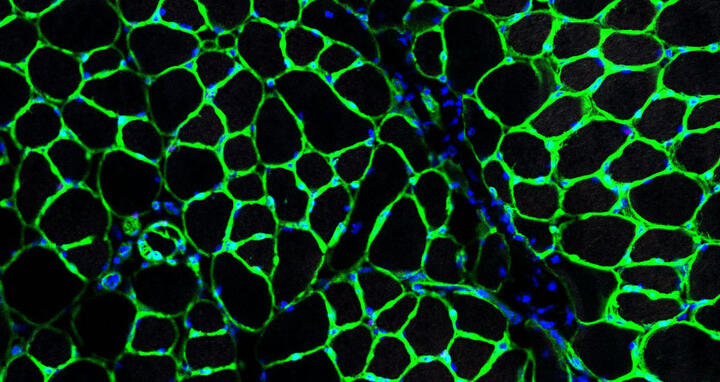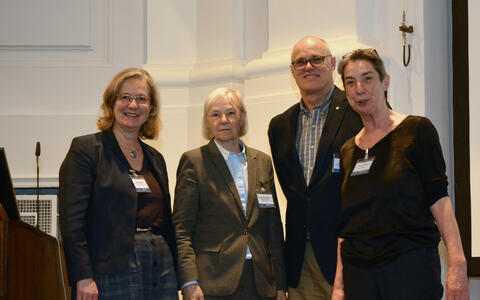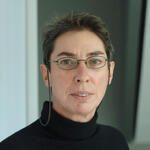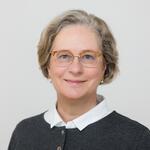Muscle research moves from the Petri dish to gene therapy
According to the event’s organizers, Professor Carmen Birchmeier and Professor Simone Spuler, both scientists at the MDC, the conference should “reflect the breadth of modern muscle research.”
Across more than 35 lectures and 120 poster sessions, the 200 conference participants presented a variety of aspects of muscle research: from embryonic development to the regeneration of muscles, its control and regulation to the investigation of new disease mechanisms and therapeutic approaches.
Margaret Buckingham (second from left) gave the opening lecture, while Michael Rudnicki (third from left) delivered the keynote lecture at the MDC’s 2018 muscle conference. Simone Spuler (far left) and Carmen Birchmeier (far right) organized the event.
“Gene scissors” combat dystrophy
Professor Rhonda Bassel-Duby from UT Southwestern, for example, presented a strategy involving the CRISPR-Cas9 system that she and other research groups around the world are hoping to use to cure Duchenne muscular dystrophy. One in 5,000 young people (predominantly males) is affected by this disease, which arises as the result of around 3,000 different individual mutations that disrupt the production of the protein dystrophin and cause muscle fibers to atrophy. “This not only affects the skeletal muscle, but also the heart,” explains Bassel-Duby. Consequently, many patients often suffer cardiac arrest in their mid-twenties.
Bassel-Duby’s team has been working for years to correct several of these gene defects with just a few strategically placed cuts to the genome. Preliminary tests on cell cultures and mice have proven successful.
Genetically corrected, twitching muscles on flexible holders in a Petri dish. Video by researchers from the University of Göttingen.
With the goal of translating her findings into clinical applications, she is now developing methods for using these gene scissors to repair muscle functionality in humans. “Various therapies have been put forward in the past, but we hope that this new approach will increase the life span of dystrophy patients while also improving their quality of life,” says the researcher.
A successful format
But new therapeutic strategies were only one part of the program – albeit a very important one for the MDC: Carmen Birchmeier and Simone Spuler are also working on a gene therapy that they hope will cure muscular dystrophies. They, however, use primary human muscle stem cells.
The MDC’s “muscle meeting” actually began one day prior to the official opening, with a satellite conference designed especially for young researchers. It therefore lasted a total of six days. Although this is unusually long for a scientific conference, the lecture hall was still full on the very last day.
“The conference format we used was very successful, and we will continue to use it in the future,” says Simone Spuler. All the lectures were held in just one hall with no parallel sessions. This meant participants never had to choose between two equally interesting topics. The lecture program was rounded off with short presentations from young researchers.
Despite the full program, participants still had plenty of time to discuss and share ideas. “The days were full of many – often very animated – discussions,” says Carmen Birchmeier. “This is precisely how new collaborations and projects come about.”








